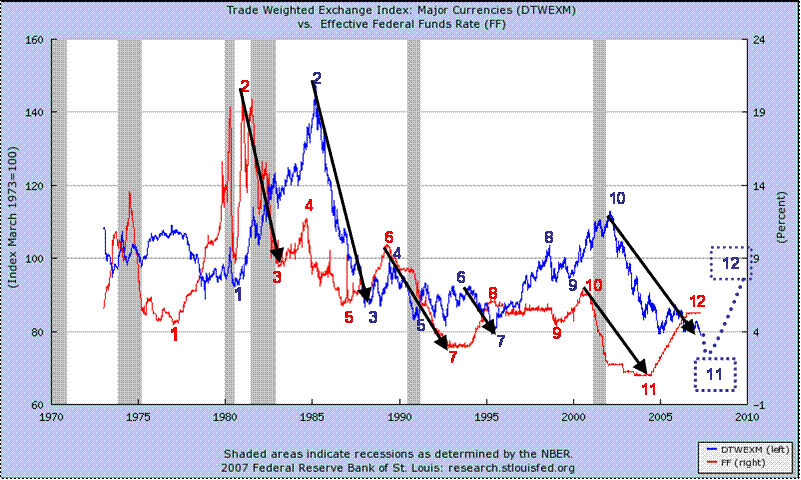Some of our PORTAFOLIO VITAL* clients have asked us why we keep invested in dollars (10-year US Treasuries at a 4.64% yield) in preparation for the coming US recession. Even as we explain in detail that log-term US treasuries generally escalate in price when recessions take hold, these customers wonder why we won’t take cover by purchasing Euros (German 10-year bunds at 4.22% yield) or Yen (Japanese 10-year JGBs at 1.62% yield). Their logic is sound; apart from the incredibly large US trade and fiscal deficits, the prospect of a US recession is currently devaluing the dollar. For instance, last week as real US GDP reached its lowest reading in four years (1.3%), the TWEX (The Federal Reserve’s Trade Weighted Major Currency Index) pierced 80%, its lowest reading since the index was started in the early seventies. However, while the whole world is predicting the dollar’s demise, we believe that once the US recession starts, the dollar will reach a bottom and all other currencies will start devaluing.
If you study the major-trend lines in the St. Louis Fed chart below, you will note that the TWEX moves in sync but countercyclical to the Fed Funds rate (FF). For instance, if you picked 1977 as the major first move for the FF curve (point 1in red), you can see that the TWEX doesn’t match that move until 3 years later (point 1in blue). From thereon, subsequent turns in the FF curve are matched countercyclically by the TWEX curve with the same time lag. In fact, if you follow the largest downturns of the FF rate versus the TWEX as pointed by the black-arrow pairs (2-3, 6-7 and 10-11) you will notice that dollar devaluation essentially takes 3 to 4 years to discount lower FF rates. Conversely, dollar revaluation takes about the same time to kick in after higher FF rates are set. Thus, no matter how big the US trade and fiscal deficits are now, point 11 red in the chart (June 2004) indicates that we are about to see point 11 blue at some point from June 2007 to June 2008. Point 11 blue will be the bottom from which dollar revaluation (the broken blue line to point 12) should come. Another thing to notice from the chart is that dollar revaluations (blue segments 1-2, 3-4, 5-6, 7-8, 9-10 and imminently 11-12) means that as US recessions (or slowdowns) pass on to the economies of the rest of the world, their currencies and commodity prices devalue.
On the other hand, “Cool economists” believe the dollar is holding its value only because foreign central bankers (meaning Asian CBs) continue propping it up so that American consumers keep buying their exports. However, the reality is that since 2002 (blue point 10), the dollar has fallen 36 percent against all the major currencies, yet, until recently, US consumer spending (financed by the housing boom) had sucked in goods, services, oil imports and investments from other parts of the world as if higher prices didn’t matter. Only now, after the housing bust, US consumers are about to start behaving as anyone whose buying power just evaporated by 36% and unfortunately, the first who are going to understand the difference this summer (versus the past 3 summers) are oil exporters like ourselves.
Furthermore, regardless of the housing boom, the 36% dollar downfall has already narrowed the US trade gap by making imports more expensive and exports cheaper: For the first two months of 2007, the deficit with the European Union was less than $13 billion, down 28% from a year earlier. With Canada, the deficit fell to below $12 billion from more than $16 billion and in February, the U.S. posted a surplus with Britain for the first time since 2001. China, of course, is a different story; by continuing to exchange their hard goods for 36% less value (the yuan is pegged to the dollar) they are basically subsidizing US consumers: A dynamic that creates Chinese growth and jobs, but inflates Chinese asset prices and diminishes their consumer purchasing power. However, now that US consumer spending is about to implode as a consequence of the housing bust, not even the Chinese subsidy may help. That will put a temporary halt to Chinese economic expansion at some point by the end of this year or the beginning of next, but its severity will depend on how long it takes for the US economy to recover from the coming recession.
*PORTAFOLIO VITAL is one of Sequoian´s most complete investment products. It allows customers to invest their long-term funds in a conservative but well-informed manner with a view to benefit from our team’s market experience and financial knowledge. If you would like more information please call Nelly Parra at 212-276-4862 or write to distribution@sequoian.com


Leave a Reply